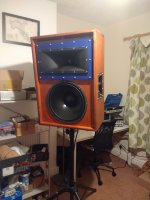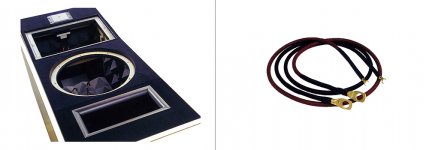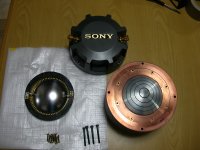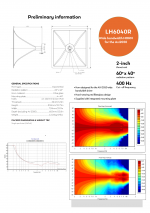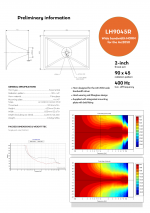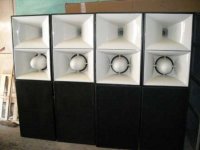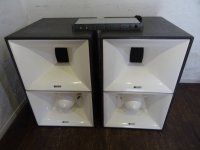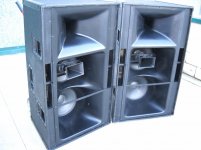You are deciding on the size of compression driver? 1" is a sweet spot. Will play loud crossed below 1kHz in a domestic environment. Crossing below 1k has its benefits as I see it. It can be tempting to use a larger driver to get another octave, don't compromise the 4-5 above it.
Have you ever compared 1.75" diaphram drivers to 3" or larger, crossed below 1000Hz?
I have and I know a few people, far more experienced than I am, that all agree on the fact that there is no comparison.
I don't share the >15Hz fetish, because of all the music I listen to, or occasionally make, 95% of the content is in the 40Hz-15Khz range.
Some 1" drivers may sound ok, even below 800Hz, the Beyma CP380M is an example. But it's not in the same league and the differences will be more pronounced at higher SPL.
Kipman725 also intends to use his speakers (semi-) professionally.
He would be one of the very few to do that with 1" drivers (and a stash of replacement diaphragms) crossed below 1000Hz.
With some of the latest large format drivers, you don't need to compromise. You do need to spend some extra money though.
Last edited:
A quick update. I ended up going with a 3 way solution, crossover points 500Hz, 1.5kHz (4th order acoustic). Drivers: Beyma 15 CM V2, 4xFaitalPRO 3FE25, P-Audio BM-D446. The mids and tweeter are attached to a P-Audio PH-4220 horn in a synergy style arrangement. A passive crossover is used on the mids/tweeter and the bass/mid crossover is done actively.
Sounds great, still need to properly characterize its performance. The bits I have written about can be found here:
BM-D446 on PH-4220
Sounds great, still need to properly characterize its performance. The bits I have written about can be found here:
BM-D446 on PH-4220
Attachments
So in the end you took on a slightly larger challenge than you originally intended?
Good to hear that you like the result.
Good to hear that you like the result.
Hello,
This is all old stuff with the edges rounded and polished.
I think of the Image Control Waveguide throats as image control weirs with well-rounded geometry. The sound travels the paths of least impedance.
Someone needs to get close and measure the distortion differences among horn throats with sharp diffraction slots, these “new” ICW’s with well-rounded geometry and throats with no groves or notches.
It may well be that in our small audiophile listening rooms that we may not perceive a difference.
Thank You DT
This is an interesting comment.
The distortion will also partly depend on the driver and the extent to which it 'fits' with the horn in question.
Nevertheless it would be interesting to compare measurements of the M2 and this 20 year old, but still highly regarded studiomonitor.
A shootout would be even better.

Last edited:
I guess it would be difficult to get the hands on an M2. The monitors above could be found within walking distance of where I am sitting right now.
Regards
Charles
Regards
Charles
If I had the choice between a pair of SE-MF-2 and M2, I would take the SE.
In monetary terms it's not a fair comparison though. You buy almost 2 pairs of M2s for 1 MF-2 Monitor.
In monetary terms it's not a fair comparison though. You buy almost 2 pairs of M2s for 1 MF-2 Monitor.
.. In monetary terms it's not a fair comparison though. You buy almost 2 pairs of M2s for 1 MF-2 Monitor.
CHF 28999.00\1 piece, passive Strauss Elektroakustik SE-MF-2 - MusiX CH
Would be interesting to know what the drivers and horn compliment is in the MF-2... Like you say Rob, would be interesting to see a comparison to the M2, even through the MF-2 appears to have higher directivity with the 90 x 40 (2380A?) pattern versus the 120 x 100 pattern of the M2 waveguide.
I recently had a member send me in-room measurements of the M2, and in his room, with no subs, the M2 is the first 2-way I have seen to legitimately cover 20 Hz to 20 kHz.
I recently had a member send me in-room measurements of the M2, and in his room, with no subs, the M2 is the first 2-way I have seen to legitimately cover 20 Hz to 20 kHz.
http://www.strauss-electroacoustics.com/download/se-katalog2” compression driver, aluminium alloy diaphragm,
neodymium magnet circuit
The MF-2 is used in many larger studios throughout Europe and in the Sony Music Studios.
At least the early versions were fitted with a TAD TL-1601a and the Sony SUP-T11 (Aluminum diaphragm).
There are also MF-2s with an additional AMT on top.
At least the early versions were fitted with a TAD TL-1601a and the Sony SUP-T11 (Aluminum diaphragm).
There are also MF-2s with an additional AMT on top.
Attachments
Last edited:
Another large horn which should be available for sale soon is Celestion's red horn made especially for the Axi2050, featuring a 2-inch throat exit with a 90x45 degree radiation pattern and 400Hz cut-off frequency.


An Italian brand offered 2 types of horns for a PA stack in the 1990's.
These were used with ferrofluid cooled BBC/B&C 3" diaphragm, 2" exit drivers.
The 60x40 horns look suspiciously similar to the Celestion Horns.
These were used with ferrofluid cooled BBC/B&C 3" diaphragm, 2" exit drivers.
The 60x40 horns look suspiciously similar to the Celestion Horns.
Attachments
Last edited:
BUT, the horns in the image above are missing an additional item.
Attachments
Last edited:
Celestion actually offers 2 horns for the Axi2050.
Specsheets:
Ah, cool. The 90 x 45 version is likely to have pattern flip though since 90 / 45 > 1.6x.
If they wanted to sell more horns in general, they should also make a 1.4" version. But I can see that is not likely to happen...
The Axi2050 is 2", but Celestion may want to develop 1.4" horns for the CDX-143.. series.
The mid horn in these RS-880s is the mother of the above horns.
It's one of the best sounding fullrange PA loudspeakers ever.
The mid horn in these RS-880s is the mother of the above horns.
It's one of the best sounding fullrange PA loudspeakers ever.
Attachments
Last edited:
Foam?
30ppi 😉
At least it looks identical.
I'll come back to this later.
Last edited:
- Home
- Loudspeakers
- Multi-Way
- 1.4" or 2" throat large constant directivity horns you can actually buy!
